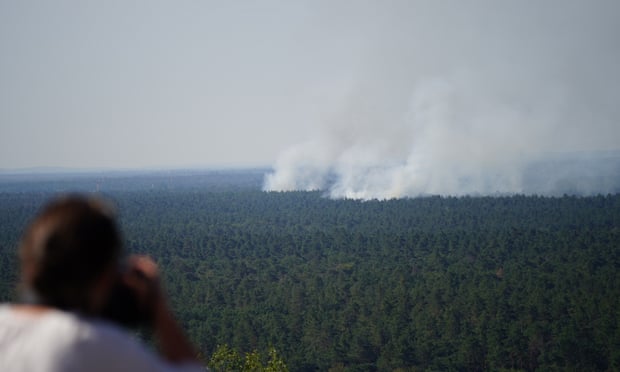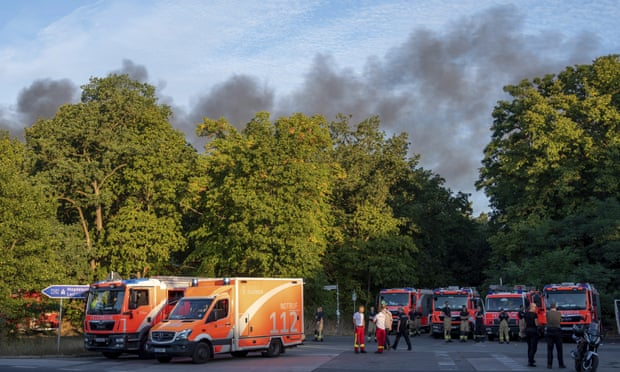daftandbarmy
Army.ca Dinosaur
- Reaction score
- 32,162
- Points
- 1,160
Ft McMurray and Williams Lake both missed this fate by just a hair's breadth. Lillooet, not so much....
The Return of the Urban Firestorm
What happened in Colorado was something much scarier than a wildfire.
On Thursday afternoon, in the space of a few hours just a day before the new year, 100-plus-mph winds carried the most destructive fire in Colorado history through the suburban sprawl of greater Denver, destroying much of the towns of Louisville and Superior and forcing tens of thousands to flee, including many who had entered shopping malls from sunny skies just a few minutes before. As many as 1,000 homes were destroyed. Two people currently remain missing; if the death count stays at zero, Colorado governor Jared Polis said Friday, it would be “a New Year’s miracle.”
By the standards of the megafires and gigafires of the last few years, the Marshall Fire was quite small — 6,000 acres, all told, once it was finally, poetically, brought to an end by snowfall on New Year’s Eve. But following the driest and second-warmest fall in 150 years, the devastation was harrowing out of proportion to its scale, since, unlike most wildfire, it was not in wildland or forest but was — as the climate scientist Daniel Swain, who lives in Boulder, put it — an “urban firestorm.”
That may sound like hyperbole, but on Friday the governor echoed the language: “It wasn’t a wildfire in the forest, it was a suburban and urban fire. The Costco we all shop at, the Target we buy our kids’ clothes at — all damaged.” In fact, though the fire did not begin there, it quickly jumped to a strip of big-box stores and their parking lots — to most Americans perhaps the very picture of an inflammable Anthropocene.* But as Swain told me on Friday when we spoke by phone, “Fire finds a way.” The way, typically, is wind; during the Marshall Fire, it carried flames and embers at hurricane-force speed for eight straight hours, consuming “football-field lengths of land in seconds.”
I wanted to start with what feels different about this fire. For a lot of Americans, the Camp Fire in Paradise, California, in 2018 may be the most horrifying recent memory — 18,000 structures burned, 85 deaths. But while Paradise was a relatively dense community, it was in what’s called the “wildland-urban interface” — essentially, houses in the woods. What we saw Thursday was so different — subdivisions, tract homes, fire just tearing through suburban environments we’ve been taught to think of as safe in every way.
There are lots of people calling this a Colorado forest fire. It was absolutely not a forest fire, by any stretch of the imagination. It arguably started as a wildfire, mainly as a brush and grass fire, with some woodland near the point of origin. But it was a wildfire that became an urban conflagration pretty quickly — just a matter of hours into the event. And that sets it apart in a lot of ways from some of the Western megafires we’ve been talking about in recent years, that burned hundred of thousands of acres, and sometimes burn hundreds or even thousands of homes, but they do so over a longer period of time.
On Twitter you called this fire in Colorado an “urban firestorm.”
This was something that we didn’t really have to think about for most of the 20th century, in relatively wealthy nations, with well-developed modern firefighting. Really the only major 20th-century urban fires in hose settings that occurred were the intentional ones during World War II, the fire bombings of Dresden and Japan. We just didn’t really have to think about that much, especially happening accidentally, in the latter half of the 20th century.
But now we’re seeing it again in the early part of the 21st century. And it’s due to a constellation of factors. Part of it is how that wildland-urban interface has greatly expanded, in some cases pretty recklessly — not only has it expanded, but it’s expanded in ways that make a lot of these structures in these neighborhoods quite vulnerable. It’s also because of climate.
Right, of course. All 20 of the largest wildfires in recorded Colorado history have taken place in the last 20 years.
But the fact that a fire can essentially become self-sustaining outside the wildland, in an urban environment — it’s a reemergence of an old problem. In centuries past, whole cities would burn down due to urban fires. You know, the Great Chicago Fire …
There’s actually a lot of cities in history — in some cases, they burned more than once.
But the reemergence of this phenomenon suggests two things. One, it suggests that the risks of the physical hazard of fire is increasing, which we know it is, for a range of reasons, including climate change and the historic policies of fire suppression and the lack of prescribed fire. But it’s also because we’ve sort of lost a lot of the knowledge and behavioral lessons of how to deal with fire in urban areas.
https://nymag.com/intelligencer/2022/01/colorado-saw-the-return-of-the-urban-firestorm.html
The Return of the Urban Firestorm
What happened in Colorado was something much scarier than a wildfire.
On Thursday afternoon, in the space of a few hours just a day before the new year, 100-plus-mph winds carried the most destructive fire in Colorado history through the suburban sprawl of greater Denver, destroying much of the towns of Louisville and Superior and forcing tens of thousands to flee, including many who had entered shopping malls from sunny skies just a few minutes before. As many as 1,000 homes were destroyed. Two people currently remain missing; if the death count stays at zero, Colorado governor Jared Polis said Friday, it would be “a New Year’s miracle.”
By the standards of the megafires and gigafires of the last few years, the Marshall Fire was quite small — 6,000 acres, all told, once it was finally, poetically, brought to an end by snowfall on New Year’s Eve. But following the driest and second-warmest fall in 150 years, the devastation was harrowing out of proportion to its scale, since, unlike most wildfire, it was not in wildland or forest but was — as the climate scientist Daniel Swain, who lives in Boulder, put it — an “urban firestorm.”
That may sound like hyperbole, but on Friday the governor echoed the language: “It wasn’t a wildfire in the forest, it was a suburban and urban fire. The Costco we all shop at, the Target we buy our kids’ clothes at — all damaged.” In fact, though the fire did not begin there, it quickly jumped to a strip of big-box stores and their parking lots — to most Americans perhaps the very picture of an inflammable Anthropocene.* But as Swain told me on Friday when we spoke by phone, “Fire finds a way.” The way, typically, is wind; during the Marshall Fire, it carried flames and embers at hurricane-force speed for eight straight hours, consuming “football-field lengths of land in seconds.”
I wanted to start with what feels different about this fire. For a lot of Americans, the Camp Fire in Paradise, California, in 2018 may be the most horrifying recent memory — 18,000 structures burned, 85 deaths. But while Paradise was a relatively dense community, it was in what’s called the “wildland-urban interface” — essentially, houses in the woods. What we saw Thursday was so different — subdivisions, tract homes, fire just tearing through suburban environments we’ve been taught to think of as safe in every way.
There are lots of people calling this a Colorado forest fire. It was absolutely not a forest fire, by any stretch of the imagination. It arguably started as a wildfire, mainly as a brush and grass fire, with some woodland near the point of origin. But it was a wildfire that became an urban conflagration pretty quickly — just a matter of hours into the event. And that sets it apart in a lot of ways from some of the Western megafires we’ve been talking about in recent years, that burned hundred of thousands of acres, and sometimes burn hundreds or even thousands of homes, but they do so over a longer period of time.
On Twitter you called this fire in Colorado an “urban firestorm.”
This was something that we didn’t really have to think about for most of the 20th century, in relatively wealthy nations, with well-developed modern firefighting. Really the only major 20th-century urban fires in hose settings that occurred were the intentional ones during World War II, the fire bombings of Dresden and Japan. We just didn’t really have to think about that much, especially happening accidentally, in the latter half of the 20th century.
But now we’re seeing it again in the early part of the 21st century. And it’s due to a constellation of factors. Part of it is how that wildland-urban interface has greatly expanded, in some cases pretty recklessly — not only has it expanded, but it’s expanded in ways that make a lot of these structures in these neighborhoods quite vulnerable. It’s also because of climate.
Right, of course. All 20 of the largest wildfires in recorded Colorado history have taken place in the last 20 years.
But the fact that a fire can essentially become self-sustaining outside the wildland, in an urban environment — it’s a reemergence of an old problem. In centuries past, whole cities would burn down due to urban fires. You know, the Great Chicago Fire …
There’s actually a lot of cities in history — in some cases, they burned more than once.
But the reemergence of this phenomenon suggests two things. One, it suggests that the risks of the physical hazard of fire is increasing, which we know it is, for a range of reasons, including climate change and the historic policies of fire suppression and the lack of prescribed fire. But it’s also because we’ve sort of lost a lot of the knowledge and behavioral lessons of how to deal with fire in urban areas.
https://nymag.com/intelligencer/2022/01/colorado-saw-the-return-of-the-urban-firestorm.html






